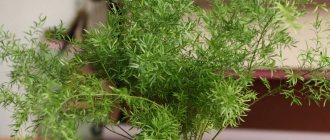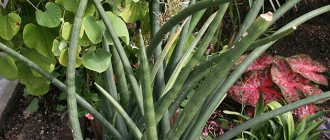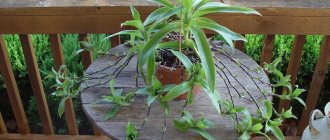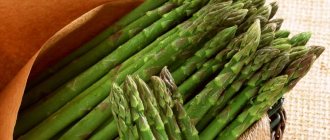Asparagus is one of the most decorative indoor flowers that can turn a room into a tropical jungle in a couple of years. The rich green color and lush above-ground cap are pleasing to the eye, and they are also almost not capricious and can adapt to any conditions. For example, even beginners in the flower business can grow crescent asparagus. This curly bush does well indoors and can even grow in partial shade. Its only requirement is moisture, both in the soil and in the air. If there is enough of it, within a year a gorgeous flower will grow from a small bush.
Botanical description of a houseplant
Crescent asparagus is a plant from the Asparagus family and is a perennial, flowering, evergreen vine. The flower's homeland is Africa and the tropical regions of Asia. In the natural environment, the shoots of this species can reach a diameter of 1 cm and a length of 15 m.
At home, the branches grow up to 4–7 m in length. The shoots grow from a tuberous rhizome, which, as the bush matures, becomes hard, like a root vegetable. Young branches are flexible, light green in color, and as they grow they become lignified and darken. Thanks to the tenacious spines located along the entire length of the branches, the vine is able to climb onto a support.
The function of the leaves of the plant is performed by the shoots of modified shoots of a flattened type, called cladode. According to the name of asparagus, the emerald leaves have a slightly curved shape, reminiscent of a sickle. The length of the leaf plates with a wavy edge is 5–8 cm, width is up to 2.5 cm.
Crescent asparagus blooms in summer. Inflorescences in the shape of a loose brush up to 10 cm long are formed by small snow-white flowers with a pleasant aroma. Typically, 6 reed petals bend back towards the sepals during flowering, exposing the middle of the flower.
After flowering, the plant forms ovaries of red-brown small berries with one or several hard seeds.
Crescent asparagus greens contain small amounts of saponins, which are toxic substances. More dangerous are berries in which the concentration of these substances is dangerous for humans and even more so for pets.
Important! The bright asparagus fruits can attract the attention of a child or animal, but eating these berries can cause severe poisoning.
Benefits and harms
Asparagus plants can grow into tall green walls of graceful stems.
The branches are tied to bamboo supports in the form of an arc or create green carpet columns.
Thanks to this decor, the apartment will seem like a wonderful greenhouse. The stems of the plant are used to decorate wedding bouquets. Branches, flowers, brown berries and leaves should not be consumed as food for animals or humans. They cause poisoning and allergic reactions.
Do not allow leaf juice to come into contact with the skin or eyes.
In this case, severe burns may occur.
Conditions for growing at home
The only difficulty for growing asparagus at home may be providing cool conditions in winter, when the plant slows down in growth and needs rest.
Placement and lighting
This resident of the tropics is not used to direct sunlight, so placement on southern window sills and direct sunlight threatens it with foliage burns. On the northern window sills, on the contrary, there is not enough lighting for the normal development and bright color of greenery. In addition, in search of light, the shoots will begin to stretch, which will spoil the decorative appearance of the crown.
The optimal location for keeping asparagus will be the eastern and western sides.
Temperature
The temperature range varies depending on age and time of year:
- seedlings take root better at a temperature of +25°C;
- an adult plant feels great at a spring temperature of +15°C;
- in summer it is comfortable at +20°C;
- in winter, the temperature should be lowered to +10°C.
Air humidity
Liana loves slightly higher air humidity - in the range of 65–70%. Regular spraying of the plant itself and the space around it will help maintain the necessary regime.
Did you know? In some countries of the Pacific region, decisions are being made at the state level to combat asparagus. The plant grows so quickly that it begins to fill the land allocated for agricultural crops.
It is imperative to ventilate the room in which asparagus is kept. In the cool season, for the period of ventilation, the flowerpot is removed from a possible draft: temperature changes are not desirable.
Home care
For the vine, you will need to install some kind of support with a stretched thin thread or fishing line so that the plant does not creep, but grows vertically. The rest of the plant care is standard: moistening, fertilizing, pruning and replanting.
Irrigation rates
Water for irrigation should not contain chlorine or any other impurities. It needs to be filtered or left for a couple of days. Ideally, the water temperature is the same as the air temperature in the room. Water the flowerpot as the soil dries out individually in each individual case.
The soil ball in the container should always be slightly damp; complete drying is unacceptable. Watering is carried out by irrigating the soil; excess water from the pan must be drained.
Top dressing
During the active growing season, asparagus needs feeding 2 times a month. Preparations for flowering plants are used, for example “Agricola”, “Tsitovit”. In summer, the frequency of fertilizing is reduced to once a month. In autumn and during the dormant period, fertilizing is not carried out.
Important! The dosage indicated in the instructions for the drug should be halved: do not overfeed the vine.
Trimming
This plant is not subject to drastic pruning; only diseased or weak branches are removed. If you want to form a certain crown shape, the necessary shoots can be shortened to the desired length. All manipulations must be carried out with disinfected and sharpened instruments. It is advisable to sprinkle the sections with crushed activated carbon.
Transfer
As the young bush grows, it actively grows additional root shoots, which over time become cramped in the pot. The root, which hardens with age, also requires replacing the cramped container.
In addition, the vine depletes the soil both during the period of growing green mass and during the flowering period, so young specimens need to be replanted and replaced with soil annually, and adults - once every 3-4 years. The time of year for the procedure is spring.
The soil for the flower should be loose and moisture-permeable.
What indoor asparagus looks like of different types and varieties: photos and names of varieties
Among the representatives of the asparagus family, a special place is occupied by edible varieties of asparagus, shown in the photo, which are grown for gastronomic purposes:
Today, for their aesthetically graceful appearance, plants are used for interior landscaping, creating original cascading ikebana flowers, arranging bouquets and other flower arrangements.
The huge variety of species and varieties does not allow us to unambiguously answer the question of what homemade asparagus looks like, since specific features and characteristics are always inherent.
However, general external characteristics characteristic of the vast majority of plants of this family can be distinguished:
- Herbaceous shrubs, lianas.
- Flexible stems.
- Leaf shoots are needle-shaped.
- Small flowers in inflorescences.
- Single-seeded decorative berries.
This homely, sophisticated asparagus flower with its lush green color will add freshness to any room and fill the atmosphere with coziness.
Modern breeding science knows more than 200 species of ornamental asparagus. However, not every species can be found in flower shops or in the collections of professional flower growers.
According to experts, no more than ten species are cultivated and grown indoors or in open ground.
For greater clarity, all descriptions of asparagus species are supplemented with photos and official names, which will help you understand in detail the specifics of each member of the family:
The most famous is the densely flowered asparagus ( Asparagus densiflorus ) - a powerful plant with sparse cladodes-shoots, its leaves are transformed into awl-shaped scales. The height of the bush is insignificant - only 45 cm, but due to the elongated shoots (more than one and a half meters), its width exceeds 6-7 m.
The leaves (or so-called phyllocladies) are small, scale-like. Once a year, the plant pleases its owners with flowering, represented by compact inflorescences of miniature white flowers. A week later, these delicate “fireflies” are replaced by round fruits of a noble burgundy color.
Breeders have developed excellent varieties of this asparagus:
"Myersii" - with distinctive shoots stretching upward.
"Sprengeri" - with characteristic long drooping branches.
's asparagus (Asparagus Meyeri) leaves are arranged much more densely in the form of a spindle. The herbaceous shrub is not large in size. Its height barely reaches 40 cm, but the branched shoots grow significantly in width - more than 5.5 m. This flower is popularly nicknamed “fox tail”, which is explained by the location of the ovaries, which gives splendor to each stem.
To figure out what this “fluffy” asparagus looks like, take a look at the photo, and you will certainly have associations with forest fur-bearing animals - after all, the “tails” in this case are shown in green color from the pot.
Crescent asparagus (Asparagus falcatus) is an excellent hanging plant that is easy to care for. It got its name due to the shape of the leaves, which resemble “sickles” with a rounded bend.
The dimensions of these slightly corrugated phylloclades are small: 5 cm in length and up to 2 cm in width. The distinctive properties of the plant are its rapid growth and cold resistance. Because of these features, this type is most often used to decorate verandas and glazed balconies, where the temperature is not always warm.
of pinnate asparagus (Asparagus plumosus) are especially elegant , which are wrapped in miniature thread-like leaves resembling scales collected in bunches.
During the flowering period, this type of indoor openwork asparagus produces tiny white flowers, which smoothly give way to dark blue berries. The fluffy, scale-like structure of the plant is widely used to decorate bouquets and ikebana flowers or to create interior partitions and decorative screens.
Just look at the photo of beautiful indoor asparagus species, and their sophisticated lace silhouette in a rich green color will certainly provoke the imagination to create a new decorative composition using them:
Along with indoor representatives, experienced gardeners grow garden specimens of the plant. The places where they grow can be open ground in summer cottages, greenhouses, and front gardens. Changeable summer weather with its characteristic slight coolness or drought is not an obstacle to the normal development of this flower.
The main garden species of asparagus shown in the photo is asparagus asparagus (Asparagus asparagoides var. myrtifolius).
For more than a decade, it has been widely used as decorative greenery in bouquets. Due to its unpretentiousness and beautiful appearance, many hybrid interpretations of it have been developed today.
A description of the varieties of asparagus with official names and photos will form a general idea of this wonderful representative of the flora:
Asparagus officinalis , popularly referred to as medicinal asparagus, is a tall herbaceous plant that can grow over 1.5 m in height. Branched thin stems bend from many sharp scaly leaves. During flowering, the plant is decorated with miniature amber flowers.
The next cold-resistant bush is Asparagus asparagus L. , which can often be found under the name white asparagus. This variety of asparagus is used for making medicines and also in the culinary industry. Externally, the plant has more powerful outlines than its decorative relatives. The height of individual specimens can be more than 2 m.
Green asparagus is considered a culinary variety of asparagus. A branched stem, small leaves, miniature flowers and dark blue oval fruits are its characteristic features.
The nutritious parts of the plant are considered to be sprouts, which are collected from May to June. The presence of a large amount of vitamins, fiber, and antioxidants was the main reason for growing this variety.
How to propagate at home
Crescent asparagus can be propagated both vegetatively and by seeds.
Seeds
Sowing of seeds is carried out in February. It is better to germinate the material in damp sand, deepening it by 1–1.5 cm. The container should be kept at a temperature of +25°C, the top should be covered with film or glass. Condensation must be removed and the soil must be moistened regularly.
In the case of asparagus, it is better to sow more seeds, since their hard shell makes them difficult to germinate. The first shoots appear after about 21–28 days. At the age of 10–12 days, young plants are transplanted into a separate container.
By dividing the rhizome
This method is used to propagate old, heavily overgrown bushes.
Did you know? In Nepal, the plant species asparagus racemosus, or asparagus racemosus, is on the verge of extinction. The reason for this is the exceptional medicinal properties of this asparagus, which locals called “the healer of 100 diseases.”
Technology:
- remove the plant from the container;
- divide the rhizome into several parts, so that each division has sprouts;
- plant the cuttings in separate containers and water them;
- seedlings should be kept in the shade at a temperature of +15°C for about a month.
Transfer
For transplantation, containers with a diameter 1.5-2 cm larger than the previous one are used. On average, a sickle-shaped asparagus bush at the age of 3-4 years needs replanting every 7-8 months. For better drainage, add a 3 cm layer of expanded clay to the bottom of the new pot, then a layer of substrate. The plant with a lump of earth is placed in a new container, covered with substrate, squeezed well, watered twice in the morning and in the evening.
During transplantation, an adult bush can be divided into two or three lobes for propagation. In this case, large pots should not be taken. The mother bush is divided according to its rhizome - each new individual should receive a developed section of the root and several young shoots.
Possible difficulties during cultivation
This liana has strong immunity against diseases of indoor flowers, but can react sharply to changes in microclimate and be attacked by insects.
Possible problems and their solutions:
- Withering and falling leaves - dry, stagnant air, too high a temperature. Treatment consists of ventilating the room, spraying the space and plant, and moving the pot to a cooler place.
- Yellowing of foliage and curling is caused by excess moisture in the soil. Irrigation needs adjustment.
- Root rot is also caused by overwatering the flower. Treatment is complete drainage of the soil clod, pruning of rotten parts of the root. When planting in a container in the ground, you need to add from 1 to 4 Glyokladin tablets.
- Dark spots on cladodes are caused by sunburn. The flowerpot should be removed from direct sunlight.
- Spider mites - appear in a dry atmosphere of stagnant air. To combat insects, the plant is sprayed with a solution of the drug “Agravertin” in a ratio of 2 ml per 1 liter of water. The room needs to be ventilated and the air humidified.
So, sickle asparagus is a popular crop for landscaping residential premises, offices and greenhouses. However, if there are children or pets in the house, you should ensure that the plant is out of their reach, especially during the fruiting period.
Features of asparagus
Asparagus is represented by herbaceous plants, shrubs and vines, which are perennials. A characteristic feature of this plant is that photosynthesis in most species does not occur in the leaves.
Asparagus flowers can be unisexual or hermaphrodite, and unisexual flowers can be found on different branches on the same bush. The biological structure of asparagus flowers is the same as that of lily flowers, but instead of a bulb they have a rhizome.
If you decide to grow asparagus, remember that once the stems are cut, they will no longer be able to grow. It is from the rhizome that new parts of the shoot grow, since they are all laid in the rhizome before growth begins. For this reason, after cutting the shoot stops growing.











